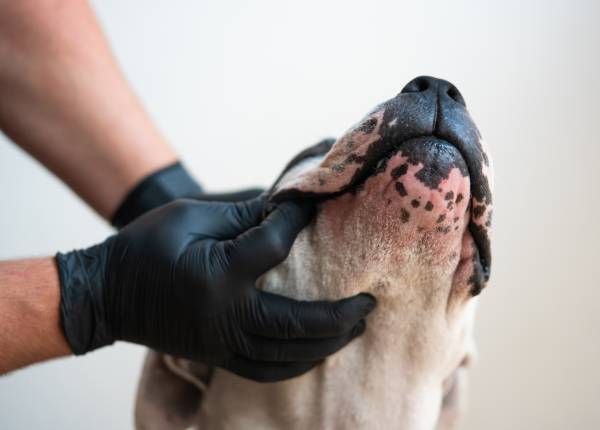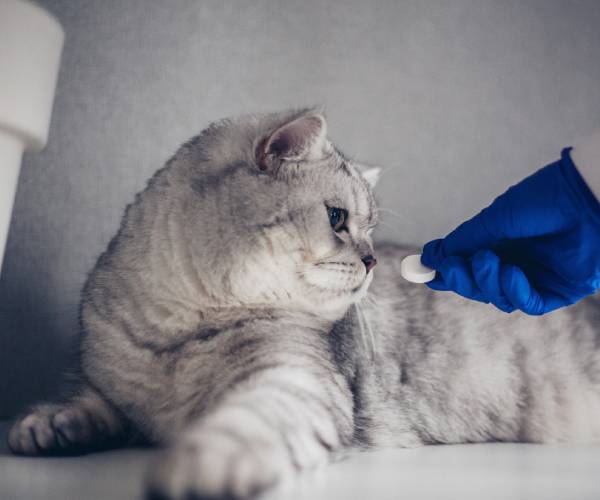Food Allergy Diagnosis in Pets – Identifying and Treating Dietary Sensitivities
Understanding Food Allergies in Pets
Food allergies in pets are a common but often misunderstood cause of chronic skin and gastrointestinal issues. Unlike food intolerances, true food allergies involve an immune system reaction and can lead to symptoms ranging from itchy skin to chronic ear infections and digestive upset.
Our veterinary dermatology clinic specializes in diagnosing and managing food allergies in both cats and dogs, using science-backed methods and individualized treatment plans.

Common Signs Your Pet May Have a Food Allergy
Food allergies often present with persistent symptoms that mimic other conditions. If your pet is experiencing any of the following signs, food sensitivity may be the cause:
- Itchy skin, especially around the face, ears, feet, or anus
- Chronic ear infections or inflammation
- Hair loss or excessive scratching
- Recurrent skin infections
- Vomiting or diarrhea
- Poor response to antibiotics or anti-itch medications
Symptoms may appear gradually, and many pets will have been treated for other conditions before a food allergy is considered.

What Causes Food Allergies in Pets?
Food allergies in pets are typically caused by protein sources the immune system mistakenly identifies as harmful. Common triggers include:
- Chicken
- Beef
- Dairy
- Eggs
- Fish
- Lamb
- Soy
- Wheat
Contrary to popular belief, grains are less frequently the cause than animal proteins.
How We Diagnose Food Allergies
Diagnosing a food allergy can be challenging because there are no reliable blood or skin tests to confirm them. The gold standard diagnostic approach is a food elimination trial, supervised by a veterinarian.
Step 1: Elimination Diet Trial
Your pet is placed on a strict, limited-ingredient or hydrolyzed protein diet for 8–12 weeks. This diet avoids any previously consumed ingredients and helps determine if symptoms improve when allergens are removed.
Step 2: Food Challenge
If symptoms resolve during the elimination phase, we systematically reintroduce individual ingredients to identify the specific allergen(s).
Step 3: Long-Term Management
Once the allergen is confirmed, we work with you to design a long-term diet plan that avoids triggers and supports your pet’s overall health.
Why Work With a Veterinary Dermatologist?
- We provide customized elimination diet plans tailored to your pet’s medical history.
- Our dermatologists can differentiate food allergies from environmental allergens, which often overlap.
- We support pet owners with clear guidance and follow-ups during the food trial process.
- Access to prescription diets and hydrolyzed protein options ensures accurate results.
FAQs About Food Allergy Diagnosis
What is the difference between a food allergy and food intolerance in pets?
A food allergy involves an immune reaction, often leading to skin and ear issues. A food intolerance usually causes digestive upset without involving the immune system.
Can a food allergy develop later in life?
Yes, pets can develop allergies to foods they've eaten for years without issue.
Are food allergies in pets permanent?
Generally, yes. Once a pet develops a food allergy, the best approach is permanent avoidance of the allergen.
Can I test my pet for food allergies at home?
Over-the-counter allergy tests are not reliable. Proper diagnosis requires a vet-supervised elimination trial.
How long until I see results from an elimination diet?
Most pets show improvement within 4–6 weeks, but the full trial usually lasts 8–12 weeks.
Is it possible for my pet to be allergic to more than one ingredient?
Yes. Some pets have multiple food allergies, which is why reintroductions should be done carefully under supervision.
Take the First Step Toward Relief
If you suspect your pet has a food allergy, our team is here to help. We offer comprehensive diagnosis and care that’s tailored to your pet’s unique needs. From chronic itching to unexplained digestive symptoms, food allergy diagnosis can provide clarity and relief.
Contact us today to schedule a consultation and start your pet’s path to better health.


